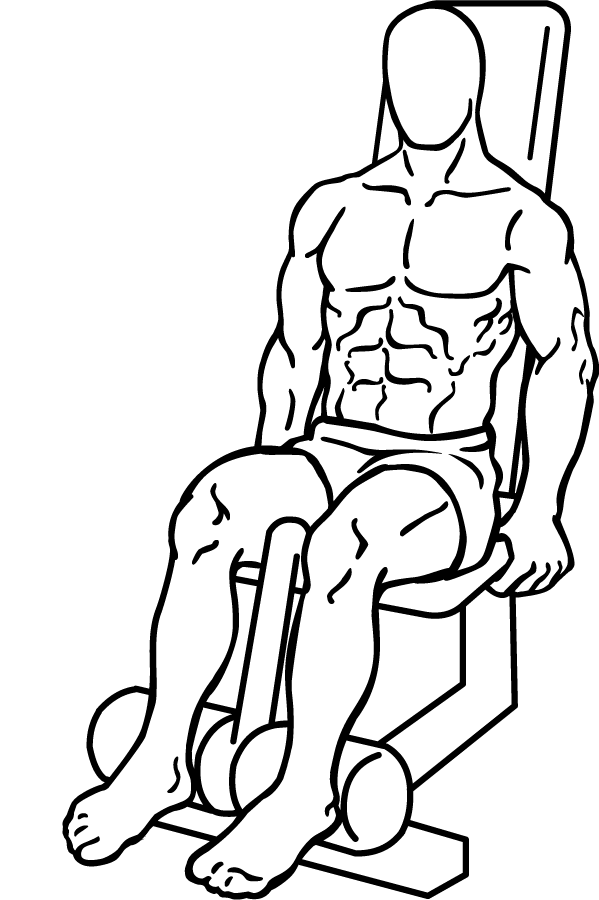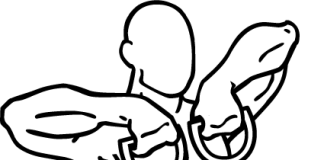Last Updated on September 25, 2014
The seated leg curl is a must-have in any lower-body workout, focusing on building strength and stability in the hamstrings. Located on the back of your thighs, the hamstrings are crucial muscles responsible for bending the knee, extending the hip, and maintaining balance. Whether you’re an athlete seeking more explosive power or someone working on general fitness, incorporating the seated leg curl into your routine can deliver impressive results. This movement isolates and activates the hamstrings in a safe, effective way while minimizing the strain on other muscle groups, allowing you to target this muscle group directly without excessive stress on the joints.
In this article, we’ll explore the ins and outs of the seated leg curl, covering everything from its setup and form to its benefits and how to avoid common mistakes. By the end, you’ll have a solid understanding of how this exercise works and why it should be a staple in your lower-body workout routine.
Why the Seated Leg Curl is Essential for Hamstring Development
The hamstrings are often overlooked in favor of the more prominent quadriceps or gluteal muscles, yet they play a vital role in overall leg strength and stability. Strong hamstrings contribute to better posture, reduce the risk of injury, and enhance your performance in physical activities, from lifting weights to running and jumping. Neglecting the hamstrings can lead to muscular imbalances, putting stress on other muscles and joints and making you more susceptible to strains and injuries.
The seated leg curl is unique in its design and effectiveness. Unlike some exercises that work the hamstrings with a standing or lying position, the seated version engages the hamstrings in a way that limits the hip movement and maximizes knee flexion, allowing for more isolated activation. This positioning lets you focus intensely on each muscle fiber in the hamstrings, resulting in enhanced muscle growth and strength over time.
Setting Up for the Seated Leg Curl
To get started, you’ll need access to a seated leg curl machine, which is commonly found in most gyms. Adjust the machine according to your body size and comfort level to ensure you’re set up correctly. First, adjust the seat back so that your knees are aligned with the pivot point of the machine. This alignment is crucial for proper form and to avoid placing unnecessary stress on the knee joint. The leg pad should rest just above the back of your ankles, providing the needed leverage for the curling movement.
Sit back against the seat with your back straight and your abs engaged to provide stability. Place your legs on top of the leg pad, making sure your knees are bent at a slight angle before beginning the movement. Grasp the handles on the sides of the machine or rest your hands on your thighs to help stabilize your upper body. This initial setup will provide a firm foundation for performing the seated leg curl effectively and safely.
Performing the Seated Leg Curl: A Step-by-Step Guide
Once you’re comfortably set up, it’s time to execute the seated leg curl with precision. Here’s how to perform each phase of the movement:
- Starting Position: With your legs resting on the pad, ensure your feet are in a natural position, and avoid pointing your toes excessively. Take a deep breath to stabilize your core and prepare for the movement.
- Curling the Weight: Exhale as you slowly bend your knees, pulling the leg pad down and toward your body. This motion will activate the hamstrings, creating tension that you’ll feel along the back of your thighs. Focus on a controlled curl, avoiding any jerking or fast movements.
- Peak Contraction: Once your legs are fully curled and the leg pad is close to your glutes, pause for a brief second. At this peak, squeeze your hamstrings tightly to maximize the contraction and engage as many muscle fibers as possible.
- Lowering Phase: Inhale as you slowly release the tension, allowing the leg pad to return to the starting position. This lowering phase, also known as the eccentric phase, is critical for muscle growth, so take your time to control the movement on the way down. Ensure that your legs return to a slightly bent position to maintain constant tension on the hamstrings.
Key Benefits of the Seated Leg Curl
The seated leg curl offers several advantages for anyone looking to build strength, improve athletic performance, or simply maintain healthy, balanced legs. Let’s look at some of the top benefits this exercise provides:
- Isolated Hamstring Activation: The seated leg curl’s design and execution allow you to target the hamstrings exclusively. Since your hips remain fixed in place, you’re able to focus solely on the knee flexion movement, ensuring a deep activation in the hamstrings.
- Reduced Stress on the Lower Back: Some hamstring exercises, such as the Romanian deadlift, place strain on the lower back. The seated leg curl offers a safer, lower-impact alternative, making it ideal for those with back issues or beginners new to hamstring training.
- Enhanced Flexibility and Mobility: Working the hamstrings through a full range of motion improves flexibility and mobility in the knees and hips. This increased range of motion can make everyday movements, from walking to bending, smoother and easier.
- Prevention of Injuries: Strong hamstrings help protect your knee and hip joints by maintaining muscular balance with the quadriceps. By reinforcing these muscles, the seated leg curl reduces your risk of common leg injuries, especially in sports that require explosive movements.
- Improved Athletic Performance: Strong hamstrings are crucial for athletes, as they play a significant role in sprinting, jumping, and changing direction quickly. Regularly incorporating seated leg curls can enhance your performance in these areas by providing more power and stability in the lower body.
Tips for Maximizing Your Results
Here are some pro tips to help you get the most out of the seated leg curl and take your hamstring development to the next level:
- Focus on the Negative Phase: The eccentric, or lowering, phase of the seated leg curl is where the hamstrings experience the most tension. By slowing down this part of the movement, you can increase muscle engagement and stimulate greater growth.
- Use a Moderate Weight: It’s essential to prioritize form and control over the amount of weight you lift. Choose a weight that challenges you but still allows you to complete each rep with perfect form. This approach will reduce the risk of injury and improve muscle recruitment.
- Experiment with Foot Positioning: Changing your foot position can slightly alter the emphasis within the hamstrings. Try pointing your toes inward or outward to activate different parts of the muscle. However, always maintain a comfortable and natural alignment to avoid strain.
- Progressive Overload: To build strength and size, gradually increase the weight or reps over time. Adding just a small amount of weight or a few extra reps each week will encourage consistent progress and help you break through plateaus.
- Stay Consistent: Consistency is key in seeing long-term gains. Include the seated leg curl in your routine regularly to keep the hamstrings engaged and growing.
Common Mistakes to Avoid
Avoiding these common mistakes will help you get the best results from your seated leg curls:
- Using Momentum: One of the biggest mistakes in the seated leg curl is allowing momentum to carry the weight. To avoid this, focus on a controlled movement with slow, deliberate reps that keep the tension on the hamstrings.
- Locking Out the Knees: At the top of the movement, avoid fully locking out your knees, as this can place unnecessary strain on the joint and reduce tension on the hamstrings. Keep a slight bend to maintain constant muscle engagement.
- Lifting Too Heavy: While challenging yourself is essential, using too much weight can compromise form and increase the risk of injury. Choose a weight that allows you to perform each rep smoothly and with full control.
- Ignoring Form: Correct form is everything in isolation exercises like the seated leg curl. Keep your back straight, abs engaged, and upper body still. Avoid leaning forward or arching your back, as this shifts the focus away from the hamstrings and can lead to injury.
Integrating the Seated Leg Curl into Your Workout
The seated leg curl can be integrated into your leg day routine alongside other exercises that target the lower body. Start your workout with compound movements like squats or deadlifts, which require more energy and engage multiple muscle groups. Then, move into isolation exercises like the seated leg curl to fully exhaust the hamstrings and enhance muscle growth. For balanced leg development, consider pairing the seated leg curl with exercises that target the quadriceps, glutes, and calves.
If your goal is to build strength, aim for 3-4 sets of 8-10 reps with a weight that allows you to complete each rep with controlled form. For muscular endurance and definition, increase the reps to 12-15 with a slightly lighter weight. Keep rest periods between sets to around 45-60 seconds to maintain muscle engagement without overtaxing your muscles.
Building Strong, Resilient Hamstrings with the Seated Leg Curl
The seated leg curl is more than just a simple isolation exercise; it’s a powerful tool for developing strong, flexible, and injury-resistant hamstrings. By incorporating this exercise into your routine, you’re not only strengthening your hamstrings but also supporting overall lower body stability and performance. Remember, consistency and form are essential in achieving results, so prioritize control over weight and take your time with each rep.
Whether you’re aiming to improve athletic performance, enhance muscular balance, or simply build a stronger lower body, the seated leg curl offers substantial benefits. Make this exercise a regular part of your leg day, stay patient, and watch as your hamstring strength and definition improve over time. A well-rounded leg workout that includes seated leg curls will provide the foundation you need for a powerful, functional, and balanced physique.


Exercise images by Everkinetic.






